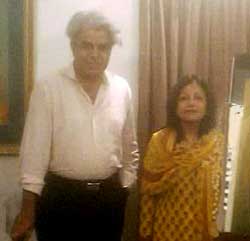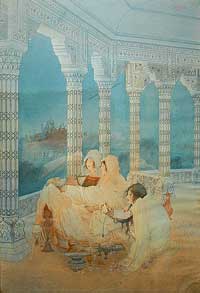 Gautam Rana of Baber Mahal Revisited pulled out a book from the treasured selection on his shelf. It was a book on the paintings of the famous Lahore-based artist, Chughtai and one I was familiar with.
Gautam Rana of Baber Mahal Revisited pulled out a book from the treasured selection on his shelf. It was a book on the paintings of the famous Lahore-based artist, Chughtai and one I was familiar with. Chughtai died in 1975 and his son, who runs an art museum in Lahore, had sent the book to Gautam in an effort to trace missing paintings by his father that had been bought by Chandra Shamsher in Mussorie in 1922.
I was going to Pakistan for an exhibition at the Alhamra Gallery and Gautam wanted me to look up Chughtai's son and his museum. He gave me a sheaf of emails as background.
Subject: Descendents of Rana Chandra Shamsher Jang Bahadur PM of Nepal 1922
Date: Mon, 18 Oct 2004 15:57:16 -0700
From: Arif Chughtai
To: g2
Dear Gautam Sahib: This is an enquiry out of the blue and concerns your prime minister in 1922 Rana Shamsher Jang Bahadur. Your prime minister had lost his wife and was visiting Mussorie in India at that time and went to an exhibition of paintings. There he saw the works of MA Rahman Chughtai or Abdur Rahman Chughtai and fell in love with them. He bought a few paintings and established contact with the artist in Lahore. We have his letters in our archives.
The painting depicted a king on his deathbed surrounded by his three daughters. It was on paper and watercolour wash and approx size 20 inches by 28 inches. We have a photograph of it as it was made in 1920.In the 1960s a Pakistani in Nepal came across a sale of household effects by a family and the things were the belongings of Rana Shamsher Jang. He bought three or four paintings and brought them here for the artist to see. This was in the lifetime of Chughtai who was astonished to see them after 40 years. However the family who sold most of his things kept a painting to hang in some library, college, auditorium or something. They said that work was very dear to Rana Sahib. This concerns research on our part and we are eager to find the location of the work. If you cannot do it yourself, get us in touch with someone who can and we will gladly assist them. I am the son of the artist and founder of his museum here in Lahore. We think the work may be in Tri Chandra College library or somewhere else. We will pay all charges involved in finding out. If you need more details, please ask me. I will be very grateful. I have already sent you a letter by post with more details. Let us revive the relation of our elders. Best wishes
ARIF RAHMAN CHUGHTAI
CHUGHTAI MUSEUM TRUST LAHORE PAKISTAN
 Two important questions came to mind: where were the Chughtai paintings in Kathmandu and what was their value on the art market? Judging from the date 1922, it was easy to conclude that the 'Shamsher Jang Bahadur' in Arif Rahman's email was actually Maharaj Chandra Shamsher. The paintings were probably in the collection of the descendents of Chandra Shamsher 's family.
Two important questions came to mind: where were the Chughtai paintings in Kathmandu and what was their value on the art market? Judging from the date 1922, it was easy to conclude that the 'Shamsher Jang Bahadur' in Arif Rahman's email was actually Maharaj Chandra Shamsher. The paintings were probably in the collection of the descendents of Chandra Shamsher 's family. This was a reminder of the fate suffered by so many Ranas who were ignorant about the value of their inheritance, the art, artefacts and jewellery that came into their possession from ancestors who were discerning collectors. I promised my cousin Gautam Rana that I would investigate.
Chughtai was known in Nepal and had influenced the work of Karna Narsing Rana, Kesab Duwadi, Uttam Nepali and Govind Dongol. It took a few days to find out that there were indeed a few valuable Chughtais in private collections in Nepal that dated back to 1922 in the family of Chandra Shamsher. Quite by coincidence, an old dealer of antiques had come by to show me two old works that looked like they were by Chughtai. I called Gautam to tell him about my discovery and asked him to correspond with Chughtai Junior in Lahore again. He wrote:
 Dear Mr Chughtai.
Dear Mr Chughtai. How are you? I would like to inform you that my cousin Sangeeta Thapa (her father is Himalaya SJB Rana who is the only Nepali to receive The Star of Pakistan) has been invited to Pakistan on 20th Nov. 2004. She is an art curator and owns the Siddhartha Art Gallery. She will be in Lahore for four days at The Alhamra Art Gallery from 20th to 24th Nov. 2004. I'm taking the liberty of giving her your email address so she can fix an appointment with you directly. She knows of two Chughtai paintings which are currently in the Nepali market. Though there is no signature, they have been identified as Chughtai's works, it is 20' x 28\' in size. Please expect her email any day. Thanking you. Yours sincerely.
Gautam SJB Rana
From: Arif Chughtai To: g2
Sent: Thursday, October 21, 2004 10:22 AM
DEAR GAUTAM SAHIB SHE WILL BE WELCOME A MILLION TIMES I WILL AWAIT TO MEET HER BY THE WAY ALHAMRA WAS FOUNDED BY MY FATHER AND EVEN THE NAME WAS GIVEN BY HIM BEST WISHES ARIF RAHMAN CHUGHTAI
I wrote to Arif Chughtai informing him of my arrival, the show at the Alhamra and my desire to see the Chughtai Museum. Arif Chughtai wrote:
Dear Ms Sangeeta:
Thanks for your information. The art world at present is allergic to Chughtai and fearful of Chughtai Museum. We are independent people who love our country and are very proud of our ideology. The present set up does not like the word ideology. Ever since my father died in 1975, the Culture people are trying to bankrupt us or move us out of existence. That is why M A Rahman Chughtai is deliberately neglected by the Govt of Pakistan. It is my efforts internationally which upsets them. The people here love Chughtai and he is the father of art in Pakistan. Alhamra was founded by my father, the insignia designed by him, the name given by him.we will talk more when we meet. You must see our establishment. You will love our efforts and you will love us. Best wishes ARIF RAHMAN CHUGHTAI
Artists in Pakistan seemed to be divided into camps for whatever reasons, like it is everywhere else. I decided to keep politics out of my conversation when I visited Arif on the second day of my trip to Lahore. Nepali artist, Shashi Shah, who was with us in Pakistan wanted to meet him too. The Chughtai Museum is in the middle of a rapidly expanding city. It has a large holding of land, many old trees and a museum complex that is still being built.
Arif took us to his office, where he generously showed us many paintings by his father and I fell in love with the Chughtai paintings all over again. Chughtai was born in Lahore in 1897 and his paintings are an exquisite synthesis of Persian and Mughal styles. His love for women, beauty and nature are expressed with sensitive and sensuous lines and colours, his compositions are amazingly varied and reveal a remarkable eye for detail.
The Museum Trust in Lahore has over 10,000 works by Chughtai: watercolours, pencil drawings, aquatints and etchings, block prints, naqashis, calligraphy, stamp designs, coin designs, national and international insignias and illustrations. It was clear we were face to face with the works of a great master whose artistic career spanned 60 years.
There are Chughtais scattered in museums and collections all over the world. I was glad that my ancestor, Chandra Shamsher, had somehow acknowledged this genius and bought his work. Arif shared the intimate circumstances that led to the paintings landing up in Nepal.
Chughtai met Aabindranath Tagore ( relative of the famous Rabindranath Tagore) in Calcutta and saw Tagore's famous 'The Last Days of Shah Jehan'. He wasn't impressed and even wrote to Tagore telling him so. He felt Tagore hadn't done enough research, the painting looked artificial, the palace was bleak, Shah Jehan's daughters did not look like they were grieving and the dying emperor looked like a mendicant.
In 1919, Chughtai visted Agra to research the imagery he needed to make his own painting on the death of Shah Jehan. He spent time at the Taj Mahal and at Mussamanbagh where Shah Jehan actually died, to research architectural, physiognomical and costume details before starting his work.
When it was ready, 'The Passing of Shah Jehan' was exhibited in Mussorie along with his other works and deliberately priced five times more than Tagore's painting. As destiny would have it, Maharaja Chandra Shamsher, who was himself in mourning at that time, visited the exhibition in Mussorie and was mesmerised by the Shah Jehan painting as soon as he saw it. He bought the painting along with a few others.
 The purchase was very important for Chughtai as it created a stir in the art market. He was not a well-known artist yet and the purchase by the Maharaja of Nepal validated his worth. Other Indian royalty followed suit and Chughtais were snapped up by important collectors in India and abroad.
The purchase was very important for Chughtai as it created a stir in the art market. He was not a well-known artist yet and the purchase by the Maharaja of Nepal validated his worth. Other Indian royalty followed suit and Chughtais were snapped up by important collectors in India and abroad. Chughtai died in 1975 but the value of his works have never been greater and his paintings now sell for thousands of pounds. But the market for Chughtais is shaky because there are many fake Chughtais cropping up. Sotheby's and Christie's still refer to Arif for authentication of his father's work.
I was moved by Arif's devotion to his father's memory and his service to the nation in maintaining the works. However, I was even more moved to learn that Chughtai, the national artist of Pakistan lay buried on the premises of this proposed museum, awaiting a final befitting mausoleum.


